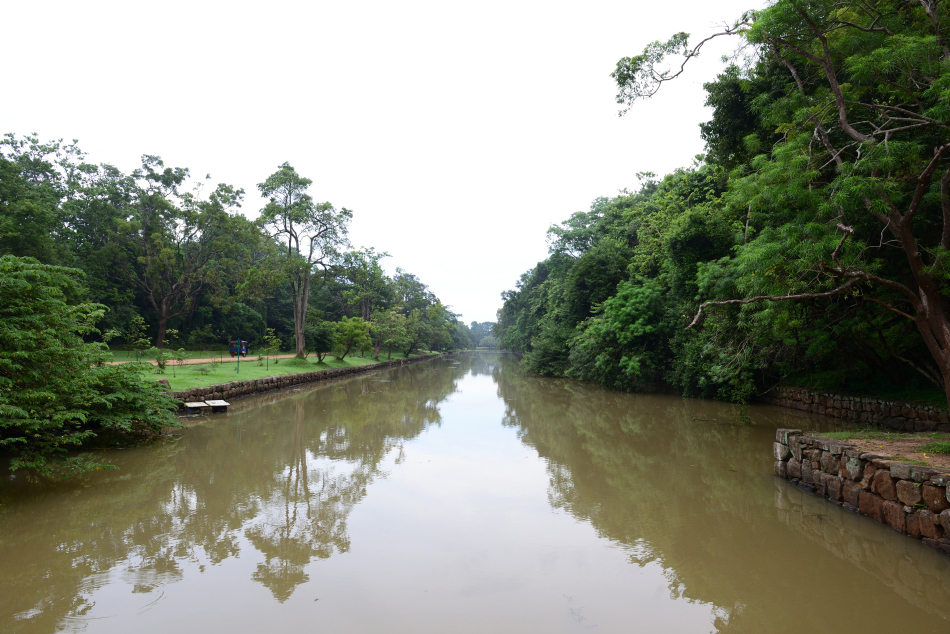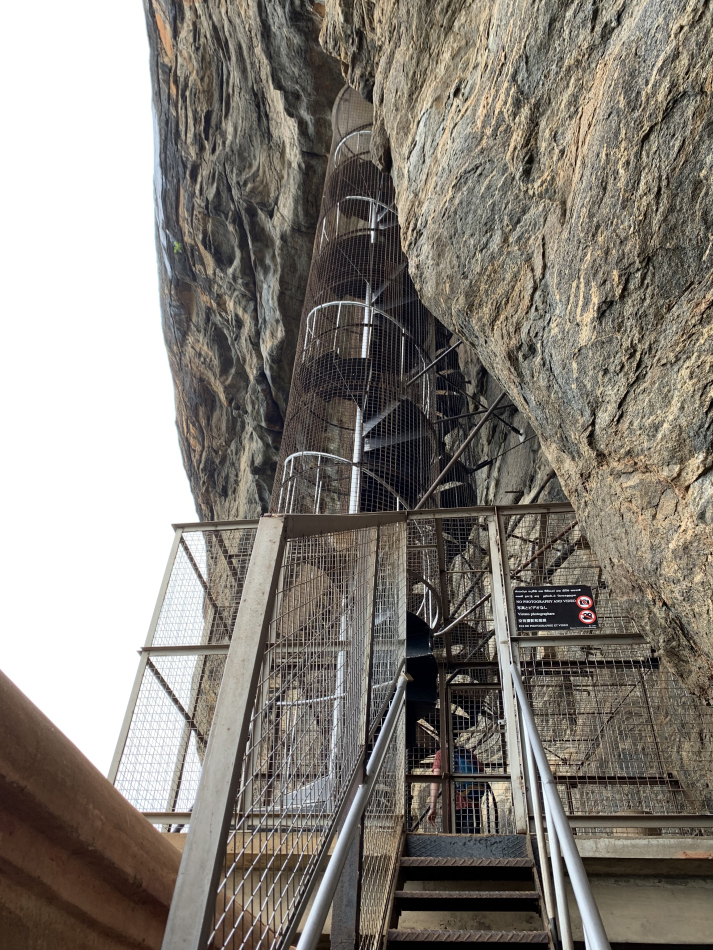SIGIRIYA ROCK, Sigiriya, Sri Lanka, 2019.12.09
Day 5 (1 of 3).
After watching the majestic sunset from Pidurangala Rock the day before, we were excited to climb the actual Sigiriya Rock in the next morning. We get up early in order to arrive at the ticket office of Sigiriya right at 7am sharp. A short tuk tuk ride dropped us off at the gate of the archaeological park.
Reaching almost 200m above the jungle, the fortress on Sigiriya Rock was the site selected by King Kashyapa (477 – 495 AD) for his new capital. In 477AD, Kashyapa I seized the throne from King Dhatusena with a coup. His half brother and legitimated heir to the throne, Moggallana, fled to South India. Kashyapa moved the capital from Anuradhapura to Sigiriya, where he erected a city around the rock and a fortress/ palace atop the plateau. Despite the effort of fortifying Sigiriya, the eventually downfall of Kashyapa was inevitable. He was eventually defeated by Moggallana, who returned to Sri Lanka in 495AD with an Indian army. After defeating Kashyapa, Moggallana returned the capital to Anuradhapura and converted Sigiriya into a Buddhist monastery which lasted for another 800 years.
 Our tuk tuk passed by the moat of the Sigiriya fortress.
Our tuk tuk passed by the moat of the Sigiriya fortress.
 After getting the admission ticket, we entered the archaeological park of the Sigiriya Rock. The short lived capital of Kashyapa lies pretty much in ruins now.
After getting the admission ticket, we entered the archaeological park of the Sigiriya Rock. The short lived capital of Kashyapa lies pretty much in ruins now.
 We did manage to arrive earlier than most tourist groups, and enjoyed a short moment of tranquility at the base of Sigiriya Rock.
We did manage to arrive earlier than most tourist groups, and enjoyed a short moment of tranquility at the base of Sigiriya Rock.
 Going through the natural triangular gateway, our 1200 steps up the rock officially began.
Going through the natural triangular gateway, our 1200 steps up the rock officially began.
 A few dogs greeted us at the beginning of the ascend.
A few dogs greeted us at the beginning of the ascend.
 At midway, we arrived at the Mirror Wall, a 3m wall covered with a glazed material that had been around for over a thousand years.
At midway, we arrived at the Mirror Wall, a 3m wall covered with a glazed material that had been around for over a thousand years.
 Apart from modern markings, some graffiti on the Mirror Wall date back to visitors between the 6th to 14th century. These markings remind us that marking graffiti at tourist attractions has been a thousand-year-old habit of humanity.
Apart from modern markings, some graffiti on the Mirror Wall date back to visitors between the 6th to 14th century. These markings remind us that marking graffiti at tourist attractions has been a thousand-year-old habit of humanity.
 A spiral staircase led us to a series of small caves where the famous ancient frescos depicting a group of beautiful ladies. It is commonly believe that the depicted ladies are either celestial nymphs or the king’s concubines. No photography was allowed.
A spiral staircase led us to a series of small caves where the famous ancient frescos depicting a group of beautiful ladies. It is commonly believe that the depicted ladies are either celestial nymphs or the king’s concubines. No photography was allowed.
 Continued onwards from the caves of frescos, we followed the only stepped path up.
Continued onwards from the caves of frescos, we followed the only stepped path up.
 The name Sīnhāgiri, or Lion Rock, came from the lion like structure of the fortress gateway at the upper platform. Two massive lion paws guard the upper fortress gateway.
The name Sīnhāgiri, or Lion Rock, came from the lion like structure of the fortress gateway at the upper platform. Two massive lion paws guard the upper fortress gateway.
 Beyond the lion gate, a narrow stair allowed visitors to ascend in single file.
Beyond the lion gate, a narrow stair allowed visitors to ascend in single file.
 After some sweat and heavy breathing, we finally reached the top of Sigiriya. The plateau top is pretty much occupied entirely by the ruins of the fortress/palace.
After some sweat and heavy breathing, we finally reached the top of Sigiriya. The plateau top is pretty much occupied entirely by the ruins of the fortress/palace.
 Looking down to where we came, we could see the central axis of the entry path.
Looking down to where we came, we could see the central axis of the entry path.
 Looking across the jungle, the lush green Pidurangala reminded us of the amazing sunset.
Looking across the jungle, the lush green Pidurangala reminded us of the amazing sunset.
 We walked around the ruined fortress for about half an hour.
We walked around the ruined fortress for about half an hour.
 The view from the top of Sigiriya was not bad, but it was not as stunning as the view from Pidurangala Rock.
The view from the top of Sigiriya was not bad, but it was not as stunning as the view from Pidurangala Rock.
 After an exhausting morning of climbing the Sigiriya Rock, we returned to the village and prepared for our departure.
After an exhausting morning of climbing the Sigiriya Rock, we returned to the village and prepared for our departure.
 We would move on to Dambulla, a transportation hub in the region which is also famous for its Buddhist cave temples.
We would move on to Dambulla, a transportation hub in the region which is also famous for its Buddhist cave temples.

Wow, I’ve never seen Sigiriya that empty! It is one of the most fascinating places I’ve ever been to, especially because of its history. It shows what some humans can and will do to stay in power.
April 9, 2020 at 12:40 am